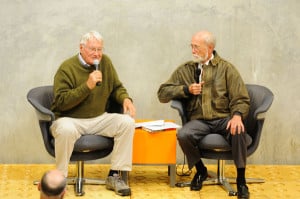In a series of remarks dominated by anecdotes and observations of the actions of companies that create successful products, Professor Emeritus James Adams supported his supposition that, when it comes to design, “emotions lead rather than follow.”
On Monday afternoon, in the industrial atrium of the Hasso Plattner Institute of Design (d.school), Mechanical Engineering Prof. David Beach sat down with Adams to discuss Adams’ book, “Good Products, Bad Products,” and to reflect on the eponymous course that Adams taught for over 20 years at Stanford.
Speaking in front of a crowd composed mainly of faculty and graduate students, the two academics touched on the nature of good design, with an emphasis on quality as the defining factor in the success and longevity of products.

Adams began the discussion by noting how alien his design methodology and philosophy was at the time he first started teaching at Stanford during the mid-1960s. The predominant thinking at the time, he explained, was to quantify quality and reject any standard that was not immediately measurable.
Adams’ deviation from this standard, instead focusing on “qualitative quality courses,” represented a major shift in the approach of design. Beach labeled this divergence the “intellectual core of our enterprise.” Despite admitting that such an understanding of quality is “monumentally slippery,” Adams asserted that, without such intuitions, the essence of good product design is lost because of his hypothesis that “quality is fundamentally a product of emotion.”
Beach chimed in, saying that, “We may think we are making rational decisions about what products we buy or what products we admire, but in fact probably the stronger driving forces have something to do with our ego, our sensory experience, cultural stimuli and the overall emotional response.”
The challenge at the time, Adams argued, was communicating this to a group of mechanical engineers, a group whose quantitative inclinations left them hesitant to adopt such an approach.
The solution, Adams repeatedly noted, was a firm grasp of aesthetic appreciation. He credited his year at the UCLA School of Art and Architecture, which took place after a “calculus-obsessed undergraduate degree at Caltech,” as the most important educational experience of his life.
“Aesthetics was the game,” Adams reflected. “And it got me thinking differently.” Adams argued that what he learned in his single year at UCLA “sensitized [him] to aesthetics.”
“Any young engineer should go to art school for a year,” he said. Adams also pointed out that creative endeavors have innate risk.
“The higher the level of creativity,” Adams said, “the higher the level of risk.”
He emphasized the need to find balance between creative design and functional design, which he grounded in the most fundamental needs a consumer will have of the product in question.
Echoing the interdisciplinary ethos of Stanford’s d.school, Adams touted the diversity of academic interests of the students he taught over the years and reflected on the future of the course, now led by Beach, and the d.school itself.
In response to an audience question about the role of high-technology tools detracting from the design process, Adams asserted, “Digital tools in manufacturing are a source of excitement and energy.”
The event, with a generally positive reception, was followed by an informal chat session.
Sanjay Dastoor, a Ph.D. candidate in mechanical engineering who took the course Good Products, Bad Products several years ago, remarked, “I am involved in a company now where we are making a tangible product, and I still draw on my experience from the class.”
“It was a great talk,” Dastoor continued. “James Adams was definitely a great teacher.”